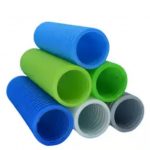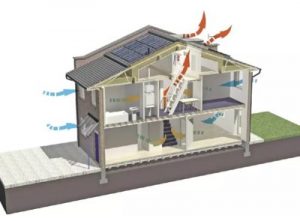KEY TAKEAWAYS
– If you plan to purchase a new air conditioner this summer, the best recommendation is looking for a product with the ENERGY STAR label.
– There are three main efficiency ratings for unitary air conditioners: CEER, SEER and IEER. They can be compared with the gas mileage value of your car, indicating how efficiently the air conditioner can convert kilowatt-hours into BTUs of cooling.
– These three ratings are used as part of the ENERGY STAR requirements for air conditioners.
– The Combined Energy Efficiency Ratio (CEER) is used by window air conditioners.
– The Seasonal Energy Efficiency Ratio (SEER) is used by central air conditioners and air-source heat pumps in cooling mode, with a cooling capacity below 65,000 BTU/hour.
– The Integrated Energy Efficiency Ratio (IEER) is used by units with a capacity of 65,000 BTU/h or above, up to 240,000 BTU/h.
– Geothermal heat pumps don’t have a specific equipment rating. They use general performance metrics that apply for all equipment: Energy Efficiency Ratio (EER) and Coefficient of Performance (COP).
As summer approaches and temperatures become higher, homeowners and businesses can expect an increase in power bills due to air conditioning. Space cooling is the highest electricity expense in most homes and commercial buildings, and power consumption increases along with outdoor temperature.
Summertime power bills can be greatly reduced with an air conditioner upgrade, but only if you purchase the right product. Any AC manufacturer can claim to offer high efficiency units, but you can only be sure if they have been certified by a neutral third party.
The best starting point is looking for air conditioners with the ENERGY STAR label, which have been independently tested according to US EPA standards. However, there are performance differences even among labeled units: by getting familiarized with the different energy efficiency ratings, you can know exactly what performance to expect.
Understanding Energy Efficiency Ratings for Air Conditioners
Depending on the type of cooling equipment, you can find several energy efficiency ratings in technical specifications. When comparing ENERGY STAR labeled air conditioning systems, you will encounter five main metrics, which are summarized in the following table:
| Energy Efficiency Metric | Abbreviation |
| Combined Energy Efficiency Ratio | CEER |
| Seasonal Energy Efficiency Ratio | SEER |
| Integrated Energy Efficiency Ratio | IEER |
| Energy Efficiency Ratio | EER |
| Coefficient of Performance | COP |
These five values have different calculation procedures but their basic principle is similar: they tell you a ratio of cooling output to electricity input, similar to the miles per gallon (MPG) of a car.
The Combined Energy Efficiency Ratio or CEER is used for window-type air conditioners, also known as room air conditioners. The CEER is a metric that indicates the cooling output in BTU, considering the power input under all operating conditions. This means the CEER considers both electricity consumption when the compressor is running, and standby consumption when the compressor is off.
The Seasonal Energy Efficiency Ratio or SEER is an efficiency metric that considers the entire cooling season, which makes it useful for estimating annual electricity costs. The SEER is used for unitary air conditioners other than window-type or PTAC, and also for air-source heat pumps in cooling mode.
The Integrated Energy Efficiency Ratio or IEER is similar to the SEER, but it has been developed for larger commercial units with a variable workload. The IEER can be described as a weighted efficiency value that considers several operating conditions and workloads:
- 95.0°F ambient temperature, 100% load, 2% of operating time
- 81.5°F ambient temperature, 75% load, 61.7% of operating time
- 68.0°F ambient temperature, 50% load, 23.8% of operating time
- 65.0°F ambient temperature, 25% load, 12.5% of operating time
The ENERGY STAR program uses the SEER for equipment below 65,000 BTU/hour of cooling capacity, and the IEER for larger equipment up to 240,000 BTU/hour.
The Energy Efficiency Ratio or EER is similar to the SEER and IEER, but it considers a single operating condition:95°F outdoor temperature, 80°F indoor temperature, and 50% relative humidity. The EER can be used for all cooling equipment, which means you can compare air conditioners of different types. However, the main disadvantage of the EER is that it only reflects performance for a specific operating condition, and AC units in buildings are exposed to a wide range of temperature and humidity levels.
The Coefficient of Performance or COP is also a general performance metric, which can be used for cooling and heating. Unlike the previous four metrics, which assume a cooling output in BTU and an electricity input in watt-hours, the COP uses the same units for energy output and input. The COP is often used to describe the performance of geothermal heat pumps, which don’t have a dedicated rating like the CEER, SEER or IEER.
Minimum ENERGY STAR Efficiency Requirements for Air Conditioners
The ENERGY STAR program has several technical requirements for HVAC equipment, which include a minimum efficiency rating. There is an extensive list of requirements for air conditioner manufacturers who want to get the label. The following table summarizes the efficiency requirements:
| Equipment Type | ENERGY STAR Efficiency Requirements |
| Window air conditioners | 9.9 – 12.1 CEER, depending on specifications |
| Central air conditioners | 15 SEER for all units below 65,000 BTU/hour |
| Air-source heat pumps | 15 SEER for all units below 65,000 BTU/hour |
| Central air conditioners with no heating system (cooling only) | 11.8 IEER for units 65,000 BTU/hour or larger |
| Central air conditioners with resistance heater | 11.8 IEER for units 65,000 BTU/hour or larger |
| Central air conditioners with other types of heating | 11.6 IEER for units 65,000 BTU/hour or larger |
| Air-source heat pumps | 11.4 IEER for units 65,000 BTU/hour or larger11 IEER for units 135,000 BTU/hour or larger |
| Geothermal heat pumps | 3.1 – 4.1 COP, depending on system configuration16.0 – 21.1 EER, depending on system configuration |
If you’re considering an air conditioner upgrade, the best recommendation is looking for an ENERGY STAR unit with the highest possible nameplate efficiency. Just keep in mind that efficiency metrics used change depending on the type of AC equipment.











